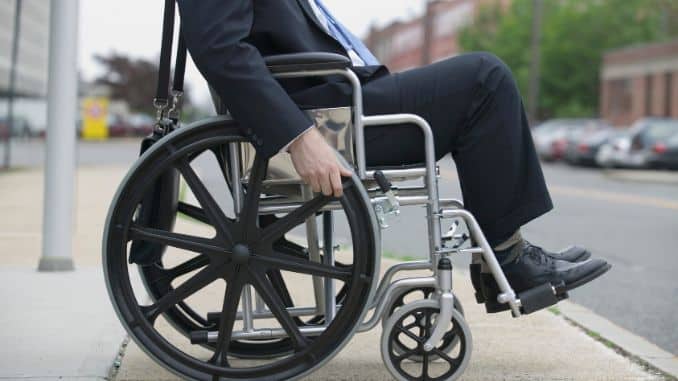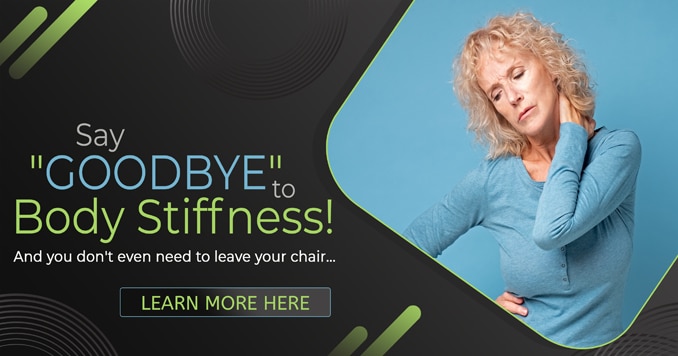Wheelchair users must stay healthy and active; plenty of exercises can help. Doing cardio exercises is great for your heart and overall fitness. It’s not just about the body; these workouts can boost your mood and make exercising more enjoyable. Strength training exercises are crucial to strengthen your muscles, especially the core and back muscles. A personal trainer can help tailor a fitness journey that suits your preferences and abilities. Customized workouts, like using resistance bands, can tone your muscles and make daily activities easier.
For your heart health, consider wheelchair sprints or hand cycling as part of your cardiovascular workouts. These not only benefit your heart but also enhance your stamina. Stretching and varied movements are essential to prevent stiffness and maintain flexibility, especially in the hip flexor region.
This guide offers a range of exercises designed specifically for wheelchair users. The goal is to create an inclusive environment for people of all abilities, whether you’re a fitness enthusiast or just starting. Together, let’s start this journey and dismantle any obstacles in our way by adopting a more active and empowering lifestyle.
Target Muscles of Exercises for Wheelchair Users
1. Upper Body Muscles
-
- Deltoids: Engaged during pushing and pulling movements.
- Pectoralis Major: Worked through chest exercises and pushing motions.
- Triceps: Activated during pushing activities.
2. Core Muscles
-
- Rectus Abdominis: Worked through core-strengthening exercises.
- Obliques: Engaged in twisting and rotational movements.
3. Back Muscles
-
- Latissimus Dorsi: Involved in pulling exercises.
- Rhomboids: Activated during rowing motions.
4. Arm Muscles
-
- Biceps: Engaged during pulling actions.
- Brachialis: Worked during pushing and pulling movements.
5. Leg Muscles
-
- Quadriceps: Engaged in leg extension exercises.
- Hamstrings: Worked during leg flexion movements.
6. Cardiovascular Endurance
-
- Engaging in wheelchair exercises also promotes cardiovascular health, benefiting the heart and circulatory system.
Benefits of Exercise for Wheelchair Users
1. Improved Cardiovascular Health
Regular exercise enhances heart and lung function, promoting better circulation and overall cardiovascular well-being.
2. Increased Strength and Endurance

Targeted workouts strengthen upper body muscles, enhancing endurance for daily activities and reducing the risk of muscle atrophy.
3. Enhanced Flexibility
Incorporating stretches and range-of-motion exercises help maintain flexibility, preventing stiffness and improving overall mobility.
4. Weight Management
Physical activity supports weight control, which is crucial for overall health and preventing obesity and other related complications.
5. Boosted Mental Well-being

Exercise releases endorphins, promoting a positive mood and reducing stress, anxiety, and depression.
6. Improved Posture and Core Stability
Core-focused exercises improve posture and stability, positively impacting spinal health.
7. Enhanced Independence
Building strength and mobility empowers wheelchair users to perform daily tasks more independently, fostering a sense of autonomy.
8. Social Engagement

Participating in adapted group exercises or games provides opportunities for social interaction, community building, and a sense of belonging.
9. Bone Health
Weight-bearing exercises, adapted to a seated position, contribute to maintaining bone density and reducing the risk of osteoporosis.
10. Long-term Health Benefits
Regular exercise is linked to a lower risk of chronic conditions such as cardiovascular disease, diabetes, and hypertension, promoting long-term health and longevity.
How Can Hip Flexor Programs Help Wheelchair Users?
- Increased mobility: A targeted hip flexor program for wheelchair users can enhance flexibility and range of motion, allowing for easier and more comfortable movement in and out of the wheelchair.
- Improved Posture: Strengthening and stretching the hip flexors contribute to better posture, reducing the risk of slouching and promoting a more aligned and stable seated position.
- Enhanced Transfer Skills: Strong and flexible hip flexors are crucial for smooth transfers between the wheelchair and other surfaces, such as beds, chairs, or vehicles, improving overall independence.
- Reduced Discomfort: Addressing hip flexor tightness can alleviate discomfort and pain associated with prolonged sitting, enhancing the overall comfort and well-being of wheelchair users.
- Optimized Function Abilities: A hip flexor program tailored to the needs of wheelchair users can optimize functional abilities, making daily activities more manageable and promoting a higher quality of life.
Safety Precautions for Seated Wheelchair Exercises
- Consult with Your Doctor: Before starting wheelchair exercises, consult your doctor to ensure they align with your fitness journey.
- Warm-Up First: Begin each session with a good warm-up to get your cardio exercises and core muscles ready.
- Secure Your Wheelchair: Ensure your wheelchair is on a stable surface and properly locked to avoid accidents during strength training exercises.
- Choose a Clear Space: Pick a spacious area for your wheelchair exercise, eliminating obstacles for improved fitness.
- Check Equipment Condition: Inspect equipment like resistance bands to ensure they are in good condition for effective back muscles and strength training.
- Gradual Progress: Progress slowly in your fitness journey, and if anything feels uncomfortable, stop and consult your personal trainer or doctor.
- Stay Hydrated: During the workout, promoting mental health and overall well-being.
- Emergency Plan: Have a plan for emergencies, such as keeping your phone nearby, an essential part of your safety measures.
- Cool Down with Stretches: After exercising, cool down with gentle stretches to relax your muscles, especially your core muscles.
- Prioritize Safety:
a. Always prioritize your safety.
b. Take it easy.
c. Listen to your body.
d. Enjoy your wheelchair workout.
Upper Body Exercises for Wheelchair Users: Good for All Ages
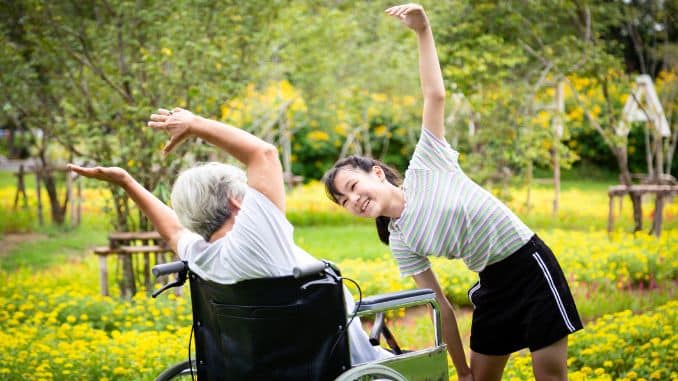
1. Side Bend
Begin in an upright sitting position, maintaining good alignment with your head, shoulders, and hips. Hold onto the seat of your chair with one hand for support. Contract your core and bend your upper body to the side, reaching over your head with your other arm while keeping your seat firmly flat on the chair. Hold this position for several deep belly breaths, in through your nose and out through your mouth. Return to the starting position and repeat the movement on the opposite side.
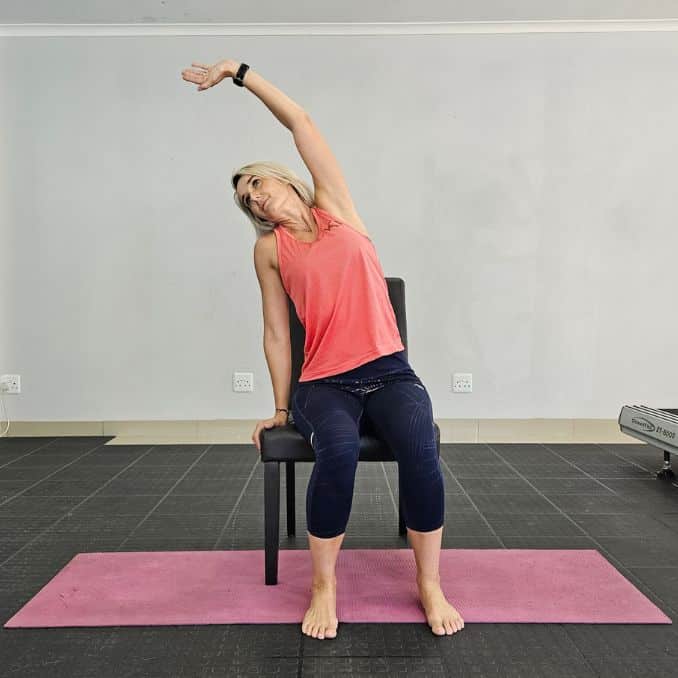 | 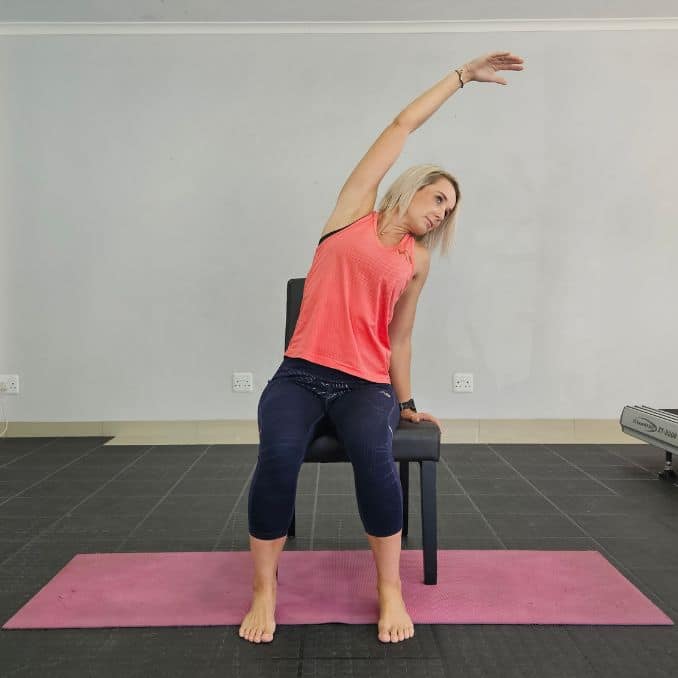 |
2. Forward Fold with Twist
Begin in an upright sitting position with your feet flat on the floor, maintaining good alignment with your head, shoulders, and hips. Move into a wide stance with your knees and toes pointing outward. Contract your core and hinge through your hips to bend your upper body forward. Twist your upper body to one side, lowering one hand towards your ankle as you extend your opposite arm towards the ceiling. Return to the starting position and repeat the movement on the opposite side.
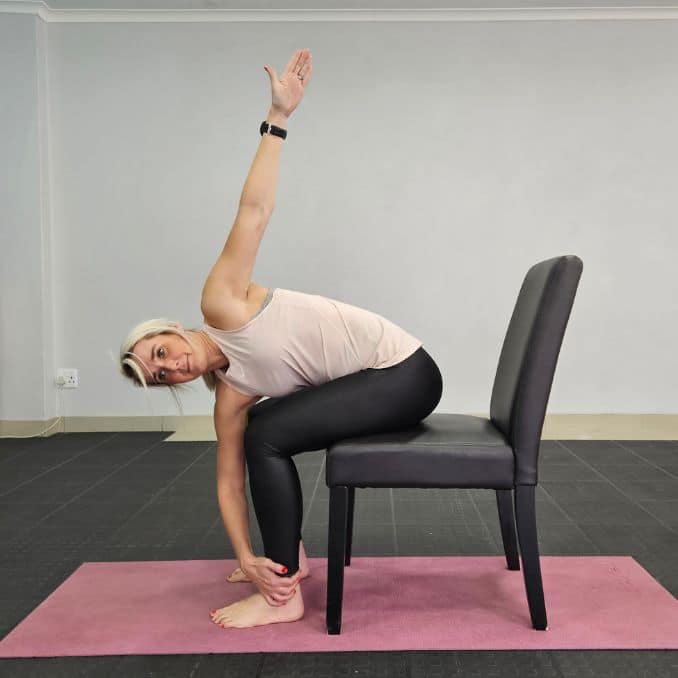
3. Scapula Squeeze
Begin in an upright sitting position with your feet flat on the floor, maintaining good alignment in your upper body. Place your hands on your thighs. Tighten your core and activate your shoulder muscles. Arch your back and squeeze your shoulder blades back until you feel a gentle stretch in front of your chest. Hold this position for several deep belly breaths, in through your nose and out through your mouth. Slowly return to the starting position and repeat the movement as needed.
Note: Make sure to keep your neck relaxed and avoid shrugging your shoulders.
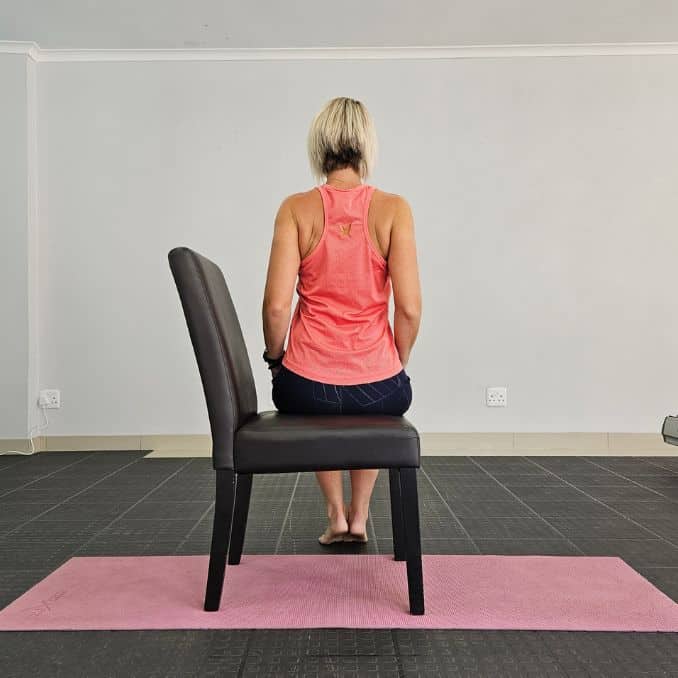
4. Seated Twists
Begin in an upright sitting position with your feet flat on the floor, maintaining good alignment with your head, shoulders, and hip. Place one hand on your opposite knee as you place your other hand on the back of the chair for support. Engage your core and twist your upper body to the side, targeting your chest muscles. Hold this position for several deep belly breaths, in through your nose and out through your mouth. Return to the starting position and repeat the movement on the opposite side.
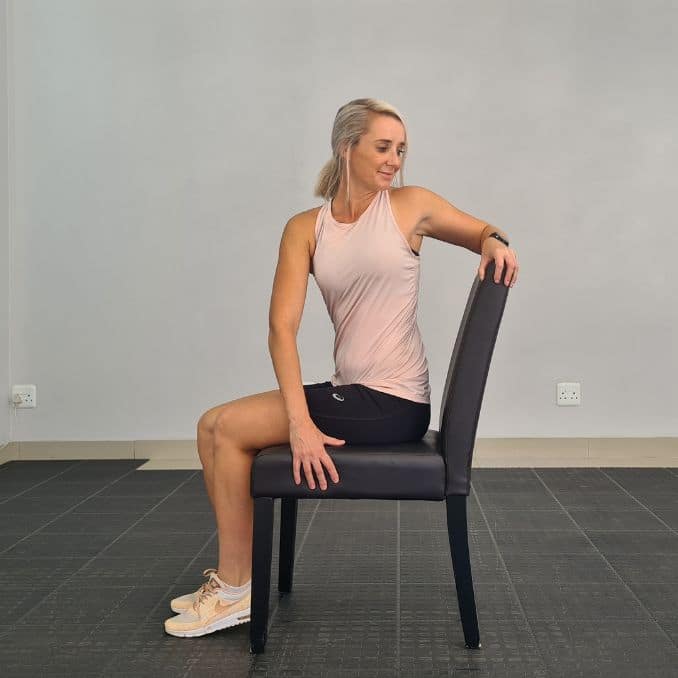
Lower Body Exercises for Wheelchair Users: Good for All Ages
1. Seated Knee Lifts
Begin in an upright sitting position with your feet hip-width apart, maintaining good alignment with your head, shoulders, and hips. Hold onto the sides of your chair with both hands for support, keeping your arms straight. Engage your core and lift one knee towards your chest, holding this position for a few seconds. Lower your leg to return to the starting position and repeat the movement on the opposite side. Start with 1 set of 10 repetitions on each side.
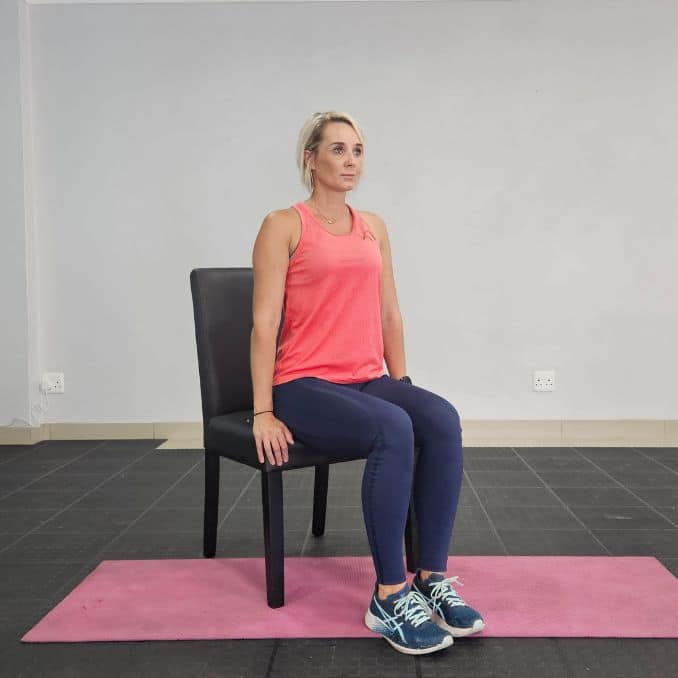 | 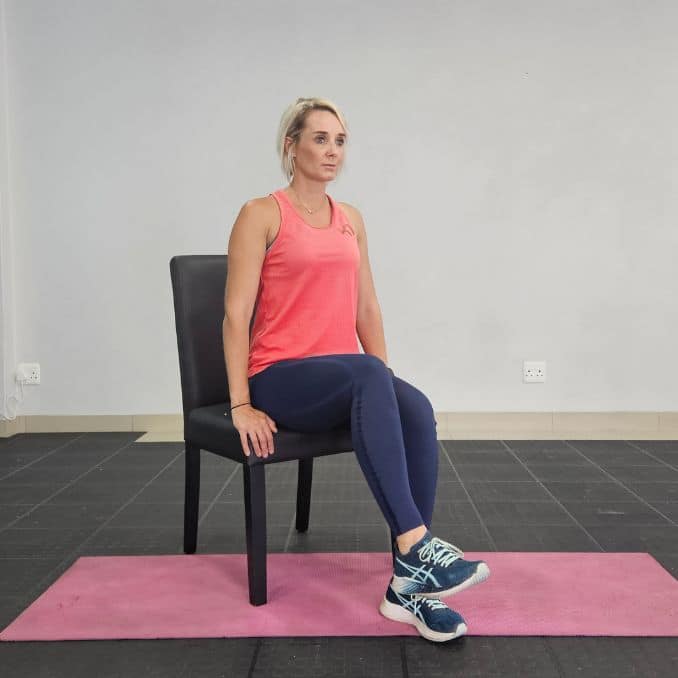 |
2. Seated Marching
Begin in an upright sitting position with your feet hip-width apart, maintaining good alignment with your head, shoulders, and hips. Hold onto the sides of your chair with both hands for support. Engage your core and lift one knee towards your chest. Lower your leg to return to the starting position and repeat the movement on the opposite leg. Repeat the movement as needed, alternating sides.
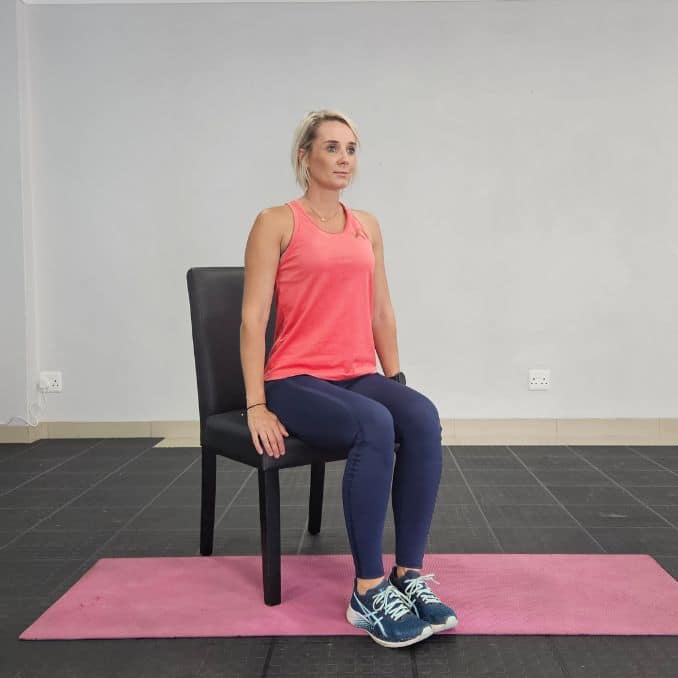 | 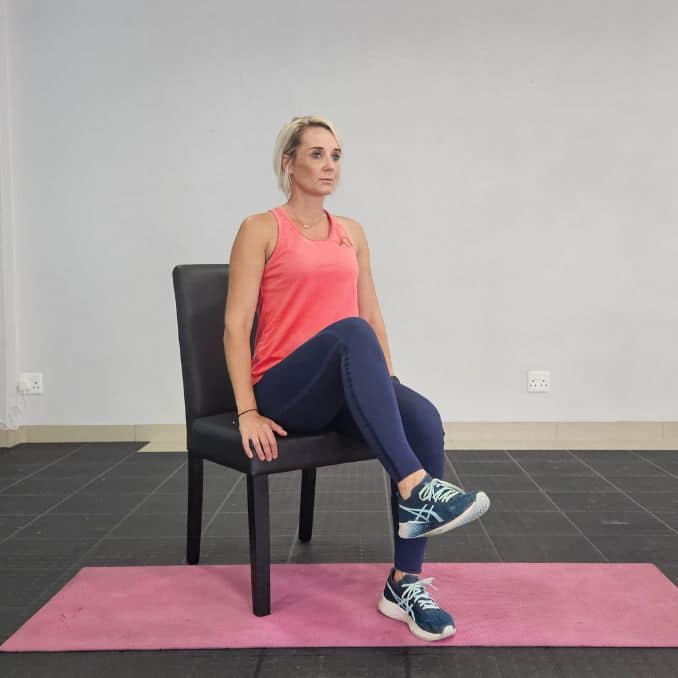 | 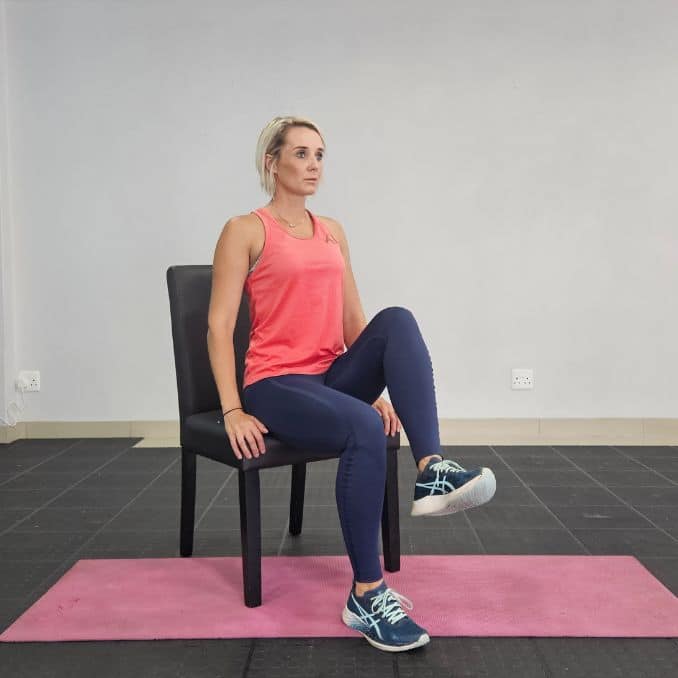 |
3. Seated Heel Raises
Begin in an upright sitting position with your knees bent and feet flat on the floor, around hip-width apart. Maintain a good alignment with your head, shoulders, and hips. Place your hands on your thighs and engage your core. Lift your heels off the floor with your toes tucked under your heels. Hold this position for several deep belly breaths, in through your nose and out through your mouth. Lower your heels to return to the starting position. Repeat the movement as needed.
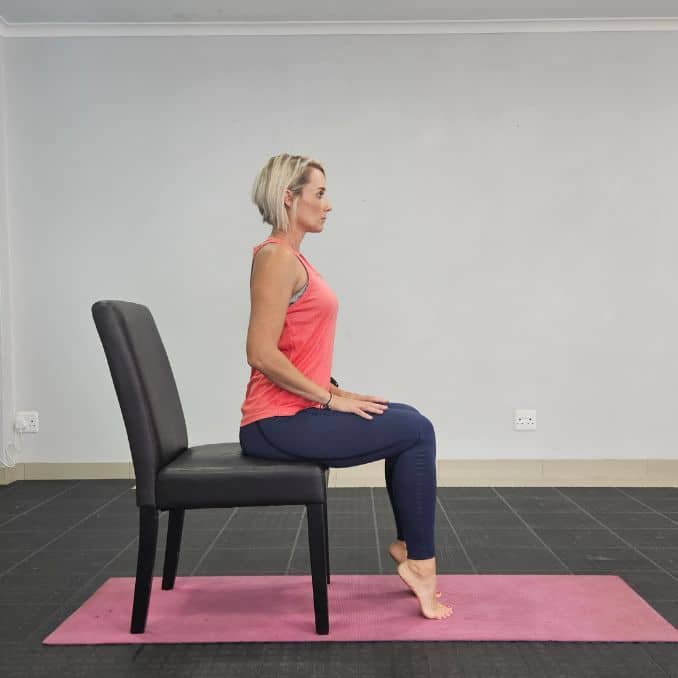
4. Seated Leg Lifts
Begin in an upright sitting position with your feet hip-width apart, maintaining good alignment with your head, shoulders, and hips. Hold onto the sides of your chair with both hands for support. Tighten your core and extend one leg in front, ideally at hip height. Hold this position for several deep belly breaths, in through your nose and out through your mouth. Lower your leg to return to the starting position. Repeat the movement on the opposite side.
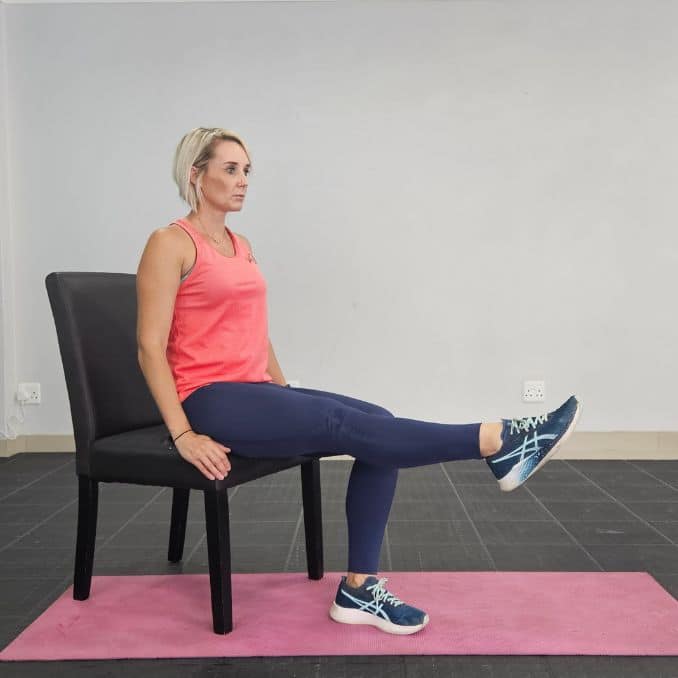
Common Barriers and Challenges Faced by Wheelchair Users in Fitness
- Lack of accessible fitness facilities and equipment: Many gyms and exercise classes are not wheelchair-friendly, limiting options for wheelchair users.
- Misconception about capabilities: There’s a common misconception that wheelchair users can’t participate in physical activities, leading to a lack of tailored knowledge and resources.
- Discouragement and uncertainty: Due to the above misconception, individuals in wheelchairs may feel discouraged or unsure about how to start their fitness journey.
- Physical limitations: The nature of wheelchair use can pose challenges in performing certain exercises or movements, requiring a focus on adaptive exercises that are both safe and effective for each individual.
Resources and Support for Wheelchair Users in Their Fitness Journey
Starting on a fitness journey as a wheelchair user may seem challenging, but plenty of resources and support are available to help you along the way. Here are some valuable resources to consider:
- Inclusive Fitness Facilities: Look for fitness centers that prioritize inclusivity and offer accessible equipment and programs. Many gyms now have certified trainers who specialize in adaptive fitness and can provide guidance and support.
- Online Communities: Join online communities or forums dedicated to wheelchair users and adaptive fitness. These platforms are a great way to connect, share experiences, and find inspiration.
- Adaptive Sports Organizations: Explore adaptive sports organizations in your area. They often offer fitness programs, classes, and events tailored to wheelchair users. Participating in adaptive sports can provide additional motivation and a sense of community.
- YouTube Channels and Online Workouts: Many fitness professionals and adaptive athletes share workout routines and exercise demonstrations on YouTube and other online platforms. These resources can help you discover new exercises and stay motivated.
Conclusion: Embracing an Active and Healthy Lifestyle as a Wheelchair User

Choosing to be active and healthy as a wheelchair user is a wise decision that can significantly impact your life. Engaging in cardio movements and focusing on improved fitness benefits your physical well-being and plays a crucial role in enhancing mental health. Wheelchair exercises specifically target core muscles, providing a friendly boost to your body. The key is not to aim for perfection immediately but to take small steps towards feeling better over time.
These exercises act as little superheroes, gradually making you stronger and more flexible. They become your partners in overcoming challenges, proving nothing can hold you back. Remember, it’s not a race; it’s about enjoying the journey and celebrating every little victory. So, keep moving, smiling, and embracing the awesome, active lifestyle uniquely yours.
Discover a healthier, more active lifestyle as a wheelchair user, breaking barriers and enhancing well-being through tailored exercises. Start your journey today with our 10 Gentle Chair Yoga Poses to Decrease Body Stiffness Bundle!

